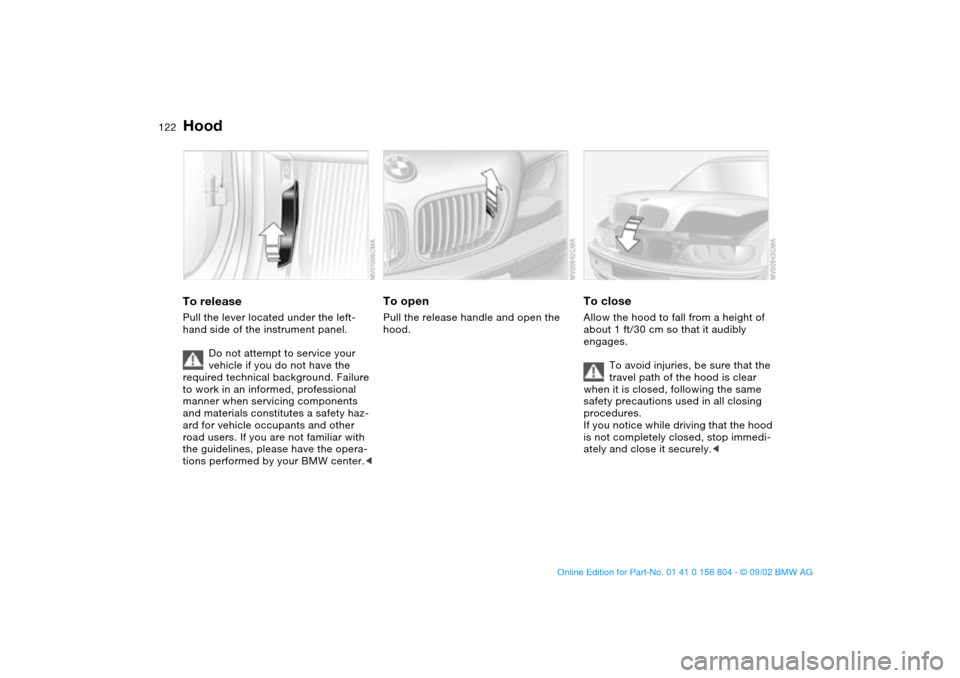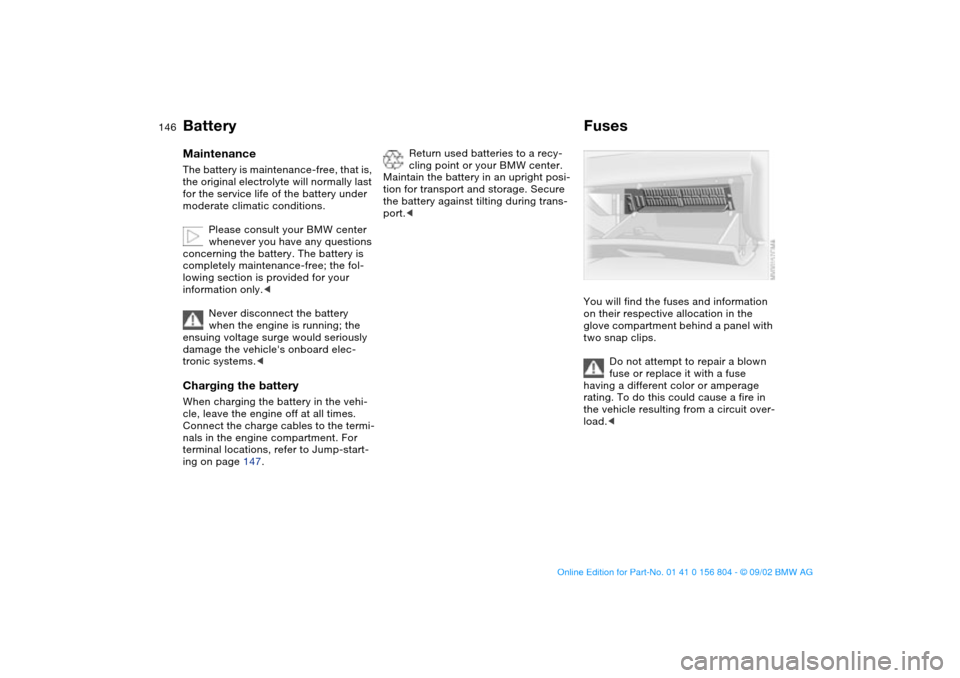2003 BMW 325i SEDAN ECU
[x] Cancel search: ECUPage 122 of 166

122In the engine compartment
HoodTo releasePull the lever located under the left-
hand side of the instrument panel.
Do not attempt to service your
vehicle if you do not have the
required technical background. Failure
to work in an informed, professional
manner when servicing components
and materials constitutes a safety haz-
ard for vehicle occupants and other
road users. If you are not familiar with
the guidelines, please have the opera-
tions performed by your BMW center.<
To openPull the release handle and open the
hood.
To closeAllow the hood to fall from a height of
about 1 ft/30 cm so that it audibly
engages.
To avoid injuries, be sure that the
travel path of the hood is clear
when it is closed, following the same
safety precautions used in all closing
procedures.
If you notice while driving that the hood
is not completely closed, stop immedi-
ately and close it securely.<
Page 142 of 166

142
Your BMW is equipped with a spare tire
or a space-saver spare tire designed for
temporary use in maintaining the vehi-
cle's mobility in an emergency.
To remove the spare tire, lift the
floor panel in the luggage com-
partment completely out, refer to
page 37.<
What you will needIn order to avoid rattling noises later,
note the position of the tools when you
remove them and return them to their
original position when you are done
using them.
>Jack 1
Lift the floor panel within the luggage
compartment, refer to page 37, and
undo the red wingnut – see arrow.
When you have completed work,
screw the jack all the way back
down. Fold the handle back and
insert it in its holder
>Chock 2
Located behind the jack on the wall
in the luggage compartment. Loosen
the wing nut to remove it
>Spare tire or space-saver spare tire –
located next to the jack
Loosen the wing nut – see arrow – by
hand, remove the storage shelf and
take the wheel out
>Lug wrench – in the onboard tool kit
on the underside of the luggage com-
partment lid, refer to page 136.Procedure1. Read and comply with the safety
precautions provided on the previ-
ous page
2. Secure the vehicle to prevent it
from rolling:
Place the wedge against the rear
surface of the front tire on the side
opposite the side being raised. If
the vehicle is parked on a down-
ward slope, place the wedge
Changing a wheel
Page 143 of 166

143
securely in front of the tire. If the
wheel must be changed on a sur-
face with a more severe slope, take
additional precautions to secure
the vehicle from rolling
3. Wheels with full wheel covers*:
Reach into the ventilation openings
and pull the cover off
4. Loosen the lug bolts by rotating
half a turn
5. Position the jack at the jacking
point closest to the flat tire – see
arrows – with the jack base verti-
cally below the jacking point and
the entire surface of the head of the
jack moves into the right-hand cor-
ner of the square recess of the
jacking point – refer to the detail in
the next illustration – when the jack
is cranked
6. Jack the vehicle up until the wheel
you are changing is raised from the
ground
7. Unscrew the lug bolts and remove
the wheel
8. Remove accumulations of mud or
dirt from the mounting surfaces of
the wheel and hub. Clean the lug
bolts
9. Position the new wheel or the
space saver spare tire on the hub
and screw at least two lug bolts fin-
ger-tight into opposite bolt holes
10. Screw in the remaining lug bolts.
Screw in all the bolts in a diagonal
pattern
11. Lower the jack and remove it from
beneath the vehicle
12. Tighten the lug bolts securely in a
diagonal pattern
Changing a wheel
OverviewControlsMaintenanceRepairsDataIndex
Page 144 of 166

144
13. Wheels with full wheel covers*:
place the wheel cover with the
valve opening – see arrow – over
the valve. Use both hands to press
the cover securely onto the rim
14. Check and correct the tire inflation
pressure at the earliest opportunity.
Vehicles with Tire Pressure Monitor
(TPM)/Flat Tire Monitor: after
mounting the spare tire or correct-
ing the tire inflation pressure, reini-
tialize the system, refer to pages 85
and 86.
Protect valve stems and valves from dirt
using screw-on valve stem caps. Dirty
valve stems frequently lead to slow
pressure loss.
Do not attempt to install the full
wheel cover on the space-saver
spare tire, since this could damage the
cover.<
The vehicle jack is designed for
changing wheels only. Do not
attempt to raise another vehicle model
with it or to raise any other type of load.
To do so could cause accidents and
personal injury.
To ensure continued safety, have the
tightness of the torque bolts checked
with a calibrated lug wrench – torque
specification: 88.5 lb ft/120 Nm – at the
earliest opportunity.<
When storing a wheel in the spare tire
recess, take care to avoid bending the
threaded rod.
If light-alloy wheels other than original
BMW light-alloy wheels have been
mounted, it may be necessary to use
different lug bolts for those wheels.
Replace the defective tire as soon as
possible and have the new wheel/tire
balanced.
Driving with the space-saver
spare tireDrive cautiously. Do not exceed a
speed of 50 mph / 80 km/h.
Be aware that vehicle handling may be
altered. Anticipate, e.g., reduced track-
ing during braking, longer braking dis-
tances, and changed steering charac-
teristics when approaching limit
conditions. These handling characteris-
tics will be even more pronounced if
winter tires are mounted.
Only one space-saver spare tire
may be mounted at one time.
Mount a wheel and tire of the original
size at the earliest possible opportu-
nity.
tions, the size of the spare tire will
differ from that of the remaining tires.
The spare tire is fully functional at all
loads and speeds. However, the spare
tire should be replaced at the earliest
possible opportunity in order to achieve
the original operating conditions.<
Changing a wheel
Page 146 of 166

146
BatteryMaintenanceThe battery is maintenance-free, that is,
the original electrolyte will normally last
for the service life of the battery under
moderate climatic conditions.
Please consult your BMW center
whenever you have any questions
concerning the battery. The battery is
completely maintenance-free; the fol-
lowing section is provided for your
information only.<
Never disconnect the battery
when the engine is running; the
ensuing voltage surge would seriously
damage the vehicle's onboard elec-
tronic systems.
Connect the charge cables to the termi-
nals in the engine compartment. For
terminal locations, refer to Jump-start-
ing on page 147.
Return used batteries to a recy-
cling point or your BMW center.
Maintain the battery in an upright posi-
tion for transport and storage. Secure
the battery against tilting during trans-
port.<
FusesYou will find the fuses and information
on their respective allocation in the
glove compartment behind a panel with
two snap clips.
Do not attempt to repair a blown
fuse or replace it with a fuse
having a different color or amperage
rating. To do this could cause a fire in
the vehicle resulting from a circuit over-
load.<
Page 160 of 166

Everything from A to ZFuel consumption 76
display 72
Fuel economy, refer to
Energy control 71
Fuel filler door 24
release following an elec-
trical malfunction 24
Fuel gauge 72
Fuel specifications 25
Fuel tank capacity 155
Fuel tank display 72
Fuel tank gauge 72
Fuel-injection system 152
Fuses, replacing 146
G
Gasoline 25
Gasoline gauge 72
Glove compartment 101
Grills 92, 96
Gross vehicle weight 154
H
Hands-free system 104
Harman Kardon premium
sound system 101
Hazard warning flashers 14
Hazard warning triangle 23
HDC Hill Descent Control 84
Head airbags 53
Head restraints 47
Headlamp flasher 90Headlamp washer system
126, 155
Headlamps 89
automatic control 89
Heated seats 50
Heating and ventilation 96
Heavy loads 108
High beams 21, 67, 90
replacing bulb 137
Hill Descent Control
(HDC) 84
Holder for
beverages 102
litter bag 103
Hood release 122
Horn 14
Hydraulic brake assistant,
see DBC
Hydroplaning 115, 117
I
Ice warning 75
Icy roads 75
Ignition key 30
Ignition lock 60
Imprint 4
Indicator lamps 18
Inflation pressure 25, 117
monitoring 85
INSPECTION 73
Instrument cluster 16
Instrument lighting 90Instrument panel 14, 16
Interface socket for onboard
diagnostics 131
Interior lamps 32, 91
remote control 32
Interior motion sensor 38
switching off 39
Interior rearview mirror 52
automatic dimming
feature 52
Interlock 60
Intermittent mode 68
J
Jack 141
Jump-starting 147
K
Key Memory 59
Keys 30
with remote control 30
L
Lamp, replacing 137
Lashing fittings 109
LATCH child-restraint
mounting system 57
Length 153
License plate lamp
replacing bulb 141
Light switch 89
Lighter 104LIGHTS ON warning 89
Litter bag holder 103
Load-securing devices 109
Lock, steering wheel 60
Low beams 89
automatic 89
replacing bulb 137
Lug wrench 141
Luggage compartment 35
capacity 154
floor mat 38
floor panel 37
lighting 35
Luggage compartment lid 35
emergency operation 35
emergency release 37
remote control 32
securing separately 35
Luggage rack 110
Lumbar support 46
M
M+S tires 120
Maintenance 73, 130
Malfunction displays 73
Manual transmission 63
MC operation, refer to the
Owner's Manual for Radio
MD operation, refer to the
Owner's Manual for Radio
Memory 49
Memory settings 59
Page 161 of 166

Everything from A to Z
161
Microfilter 95, 100
Microphone 104
Mirror
automatic curb monitor 50
Mirror defrosting 51
Mirror memory 49
Mirrors 51
Modifications, technical 5
Multifunction switch 67
N
Navigation system, refer to
the separate Owner's
Manual
Neckrest 47
O
OBD interface socket 131
Obstruction protection 40
Odometer 71
Oil
capacity 155
quality 127
viscosity 127
Oil additives 127
Oil change intervals, refer to
the Service and Warranty
Information Booklet for US
models/Warranty and Ser-
vice Guide Booklet for
Canadian models
Oil consumption 126Oil dipstick 126
Oil filter change 155
Oil level
checking 126
indicator lamp 18
Oil pressure
indicator lamp 18
OIL SERVICE 73
Oil types 127
Onboard computer, refer to
the Owner's Manual for
Onboard Computer
Onboard tool kit 136
Operating elements 14
Outlets, ventilation 92, 96
Outside temperature dis-
play 75
P
Panel lighting 90
Panic mode – trigger
alarm 32
Park Distance Control
(PDC) 77
Parking aid 77
Parking brake 62
Parking lamps 89
replacing bulb 138
PDC Park Distance
Control 77
Pocket flashlight 102
Pollen 95, 100Power output 152
Power seat 46
Power windows
safety switch 41
Pressure, tires 25, 85, 117
monitoring 85
R
Radiator 155
Radio, refer to the Owner's
Manual for Radio
Rain sensor 68
Range 76
Reading lamps
front 91
rear 91
Rear backrest, folding 106
Rear center 3-point safety
belt 106
Rear lamps 139
Rear window defroster
94, 99
Rearview mirror 51
Recirculated-air mode
94, 99
Reclining seat 44
Refueling 24
Remote control 31
Remote control keys 30
Replacement key 30
Reporting safety defects 6
Reserve indicator lamp 72Reverse 63
Roller sun blind 100
Roof load capacity 154
Roof-mounted luggage
rack 110
Run Flat tires 119, 145
S
Safe seating position 44
Safety belt height adjust-
ment 48
Safety feature 40
Seat adjustment 44
mechanical 45
power 46
Seat heating 50
Seat memory 49
Securing cargo 109
Securing devices 109
Selector lever, automatic
transmission 64
Service and Warranty Infor-
mation Booklet 130
Service interval display
73, 130
Shiftlock 64
Side airbags 53
Size 153
Ski bag 107
OverviewControlsMaintenanceRepairsDataIndex